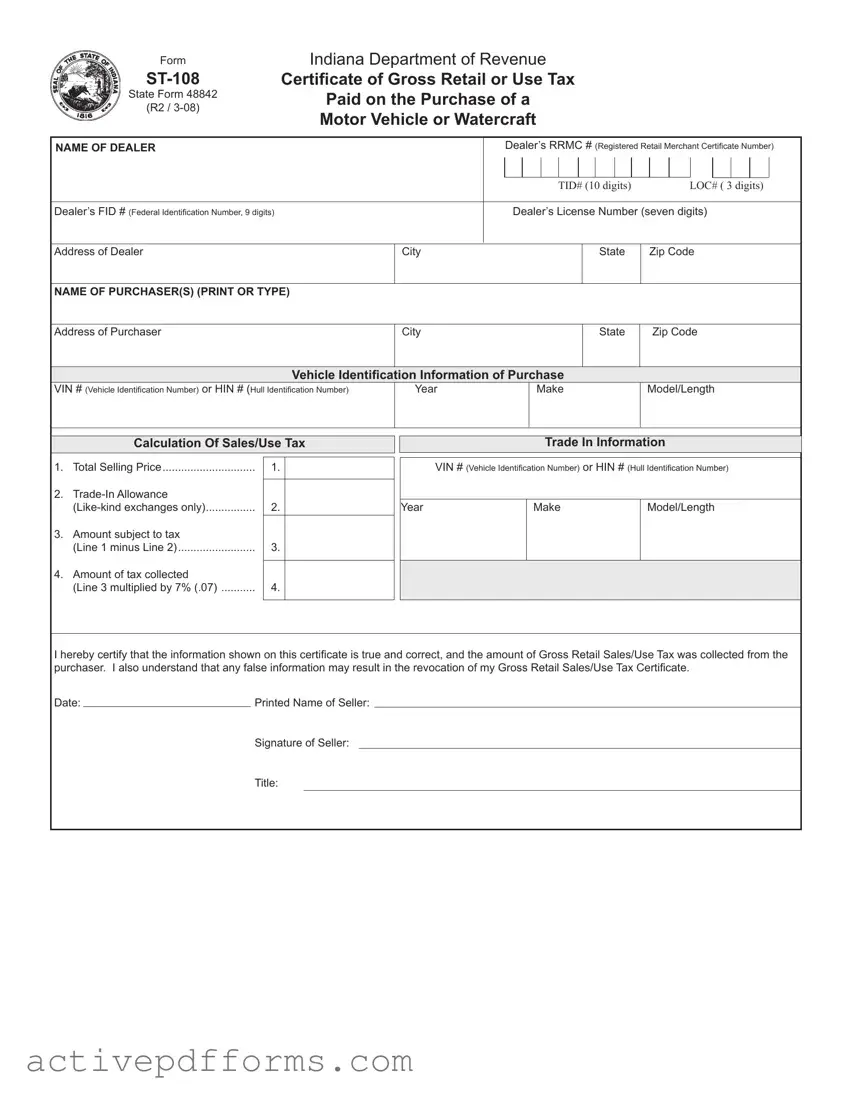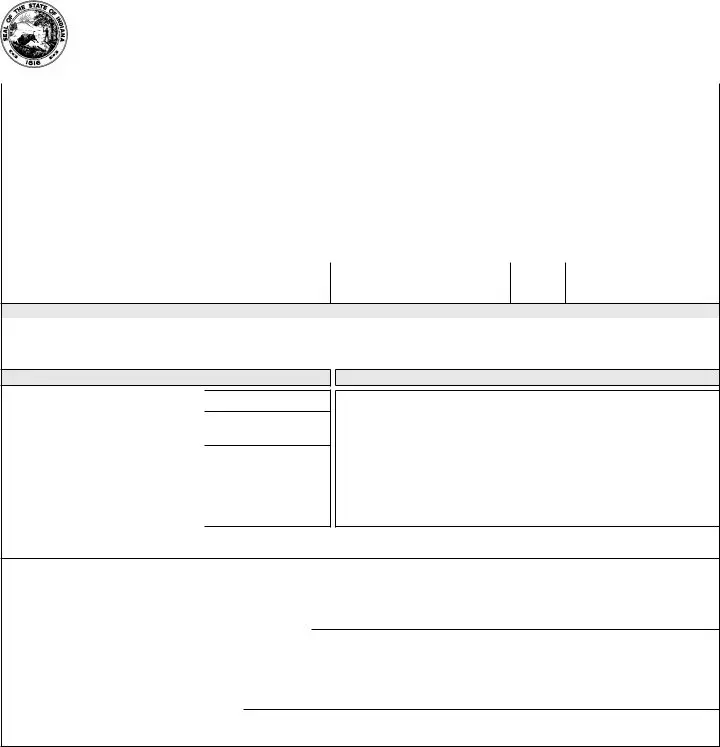Form
ST-108
State Form 48842
(R2 / 3-08)
Indiana Department of Revenue
Certificate of Gross Retail or Use Tax
Paid on the Purchase of a
Motor Vehicle or Watercraft
NAME OF DEALER |
|
|
Dealer’s RRMC # (Registered Retail Merchant Certificate Number) |
|
|
|
|
|
|
|
|
|
|
|
|
|
|
|
|
|
|
|
|
|
|
|
|
|
|
|
|
|
|
|
|
|
|
|
|
|
|
|
|
|
|
|
TID# (10 digits) |
|
|
LOC# ( 3 digits) |
|
|
|
|
|
|
|
|
|
|
|
|
|
|
|
|
|
|
Dealer’s FID # (Federal Identification Number, 9 digits) |
|
|
Dealer’s License Number (seven digits) |
|
|
|
|
|
|
|
|
|
|
|
|
|
|
|
|
|
|
|
|
Address of Dealer |
City |
|
|
|
|
|
|
|
State |
|
Zip Code |
|
|
|
|
|
|
|
|
|
|
|
|
|
|
|
|
|
|
|
|
Name of Purchaser(s) (pRINT OR tYPE) |
|
|
|
|
|
|
|
|
|
|
|
|
|
|
|
|
|
|
|
|
|
|
|
|
|
|
|
|
|
|
|
|
|
|
|
|
|
|
|
Address of Purchaser |
City |
|
|
|
|
|
|
|
State |
|
Zip Code |
Vehicle Identification Information of Purchase
VIN # (Vehicle Identification Number) or HIN # (Hull Identification Number) |
Year |
Make |
Model/Length |
|
|
|
|
Calculation Of Sales/Use Tax
1. |
Total Selling Price |
1. |
|
2. |
Trade-In Allowance |
|
|
|
(Like-kind exchanges only) |
2. |
|
3. |
Amount subject to tax |
|
|
|
(Line 1 minus Line 2) |
3. |
|
4. |
Amount of tax collected |
|
|
|
|
|
(Line 3 multiplied by 7% (.07) |
4. |
|
|
|
|
|
Trade In Information
VIN # (Vehicle Identification Number) or HIN # (Hull Identification Number)
I hereby certify that the information shown on this certificate is true and correct, and the amount of Gross Retail Sales/Use Tax was collected from the purchaser. I also understand that any false information may result in the revocation of my Gross Retail Sales/Use Tax Certificate.
Date: |
|
Printed Name of Seller: |
|
|
Signature of Seller: |
|
|
|
Title: |
Instructions for completing Form ST-108, Certificate of Gross Retail
or Use Tax on the Purchase of a Motor Vehicle or Watercraft.
INDIANA CODE 6-2.5-9-6 requires that a person titling a vehicle or watercraft present certification indicating the state gross sales and use tax has been paid; otherwise the payment of the tax must be made directly to a Bureau of Motor Vehicles license branch.
The ST-108 allows the dealer to indicate the amount of tax collected from the purchaser. The dealer is then required to submit the sales/use tax to the Department of Revenue on a sales and use tax report.
If an exemption from the tax is claimed, the purchaser and the dealer must complete Form ST-108E and submit it to the license branch at the time of licensing. ST-108E serves as an affidavit of exemption by the purchaser and lists the exemptions available to qualified purchases.
Seller Information
NAME OF DEALER: Indicate the name of the dealer as it appears on the Registered Retail Merchant Certificate (RRMC).
FID # (Federal Identification Number): Indicate the Federal Identification Number of the dealer, if applicable.
Dealer’s License #: Indicate the Dealer’s License Number(seven digits) as it appears on the Dealer’s License Certificate.
RRMC # (same as TID # - 10 Digits + LOC # - 3 Digits): Indicate the Indiana Taxpayer Identification Number and Location Number as it appears on the Registered Retail Merchant Certificate. This number must be in the following format: 0001234567-001. If this number is not present or not in this format the ST-108 WILL BE REJECTED by the license branch and the purchaser will have to return to the seller to obtain the valid number.
Address of Dealer: Indicate the address of the dealer as it appears on the Registered Retail Merchant Certifi- cate.
Vehicle Identification Information
VIN or HIN ID #: Enter the Vehicle ID # (VIN) or the Hull ID # (HIN).
YEAR: Indicate the year the motor vehicle or watercraft was manufactured.
MODEL # OR WATERCRAFT LENGTH: If a motor vehicle is being sold indicate the model name for the vehicle. If a watercraft is being sold indicate the length of the craft.
Calculation of Sales/Use Tax
TOTAL SELLING PRICE: When determining the total selling price include all delivery, make ready, repair, or other costs incurred prior to transfer to the buyer. Federal excise tax is NOT included.
TRADE-IN ALLOWANCE: The trade-in allowance exemption is for like-kind vehicles or watercraft only. (i.e. A boat may be traded for a car; however, the value of the non like-kind items do not reduce the taxable selling price).
You must also indicate the make, model, year, and ID # of the trade-in vehicle or watercraft.
AMOUNT SUBJECT TO TAX: Line 1 minus Line 2 results in the amount on which the sales/use tax will be calcu- lated.
AMOUNT OF TAX COLLECTED: Line 3 multiplied by 7% or .07 equals the amount to be collected by the seller.
Signature Section: The Seller must sign the ST-108 certifying seller has collected the sales/use tax and will forward it to the Department of Revenue with the Sales/Use Tax Return. Failure to sign the ST-108 will result in the rejection of the form by the license branch and the purchaser will have to return to the seller for the signature.


